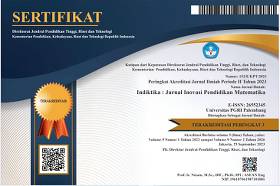Perbandingan Math Anxiety dan Interest in Learning Mathematics Siswa Laki-laki dan Perempuan Sekolah Dasar di Pekanbaru
DOI:
https://doi.org/10.31851/indiktika.v6i1.13582Keywords:
math anxiety, interest in learning mathematics, genderAbstract
This research aims to figure out whether there is a comparison of math anxiety and interest in learning mathematics for male and female elementary school students in Pekanbaru. The method used in this research is the comparative survey method. The subjects of this research were 129 students (70 men and 59 women) from 3 schools in Pekanbaru. This research obtained that male students' math anxiety (72.9) was higher than female students (63.1) and male students' interest in learning mathematics (76.09) was also higher than female students (51. .85). The findings of this research show that there is a significant difference in math anxiety and interest in learning mathematics between male and female students.
References
Annisa, A., Putra, Z. H., & Kurniaman, O. (2020). Perbandingan Hasil Belajar Matematika Siswa Kelas IV yang Mengikuti dengan yang Tidak Mengikuti Bimbingan. Jurnal Ilmiah Aquinas, 3(2), 266-286.
Apriyani, D. D., & Sirait, E. D. (2021). Pengembangan Instrumen Minat Belajar Siswa pada Pelajaran Matematika. SAP (Susunan Artikel Pendidikan), 6(1), 99-104.
Arikunto, S. (2010). Prosedur Penelitian. Rineka Cipta.
Auliya, R. N. (2016). Kecemasan Matematika dan Pemahaman Matematis. Formatif: Jurnal Ilmiah Pendidikan MIPA, 6(1), 12-22.
Cohan, L., Manion, L., & Morrison, K. (2007). Research Methods in Education. Routledge.
Dowker, A., Sarkar, A., & Looi, C. Y. (2016). Mathematics Anxiety: What have we learned in 60 years? Frontiers in psychology, 7(508), 1-16.
Friantini, R. N., & Winata, R. (2019). Analisis Minat Belajar pada Pembelajaran Matematika. JPMI (Jurnal Pendidikan Matematika Indonesia), 4(1), 6-11.
Hidayat, P. W., & Widjajanti, D. B. (2018). Analisis Kemampuan Berpikir Kreatif dan Minat Belajar Siswa dalam Mengerjakan Soal Open Ended dengan Pendekatan CTL. Pythagoras: Jurnal Matematika dan Pendidikan Matematika, 13(1), 63-75.
Hidayati, H. A., & Munandar, D. R. (2023). The Influence of Mathematics Learning Interest on The Conceptual Understanding of Eighth-Grade Middle School Students. Union: Jurnal Ilmiah Pendidikan Matematika, 11(1), 136-142.
Imro’ah, S., Winarso, W., & Baskoro, E. P. (2019). Analisis Gender terhadap Kecemasan Matematika dan Self Efficacy Siswa. KALAMATIKA Jurnal Pendidikan Matematika, 4(1), 23-36.
Kusumawati, R., & Nayazik, A. (2017). Kecemasan Matematika Siswa SMP berdasarkan Gender. Journal of Medives: Journal of Mathematics Education IKIP Veteran Semarang, 1(2), 92-99.
Saputra, P. R. (2014). Kecemasan Matematika dan Cara Menguranginya (Mathematic Anxiety and How to Reduce it). Pythagoras: Jurnal Pendidikan Matematika, 3(2), 75-84.
Siagian, S. S., Mujib, A., & Zahari, C. L. (2022). Analisis Tingkat Kecemasan Matematika dalam Pembentukan Konsep Image Siswa. Paradikma: Jurnal Pendidikan Matematika, 15(1), 8-13.
Solikah, M. (2012). Pengaruh Kecemasan Siswa pada Matematika dan Motivasi Belajar Terhadap Prestasi Belajar Matematika. MathEdunesa, 1(1), 1-8.
Stoehr, K. J. (2017). Mathematics Anxiety: One size does not fit all. Journal of Teacher Education, 68(1), 69-84.
Sudjana, S. (1996). Metode Statiska. Tarsito.
Sugiyono, S. (2019). Metode Penelitian Pendidikan (Kuantitatif, Kualitatif, Kombinasi, R&D dan Penelitian Pendidikan). Alfabeta.
Suren, N., & Kandemir, M. A. (2020). The Effect of Mathematics Anxiety and Motivation on Students' Mathematics Achievement. International Journal of Education in Mathematics, Science and Technology (IJEMST), 8(3), 190-218.
Sutrisno, H. (1986). Statistik II. UGM Press.
Tomigolung, S., & Tauran, S. F. (2021). Analisis Terhadap Math anxiety Siswa SMP Berdasarkan Gender pada Masa Pandemi Covid-19. Jurnal Padegogik, 4(2), 52-59.
Yoenanto, N. H. (2002). Hubungan Kemampuan Memecahkan Soal Cerita Matematika dengan Tingkat Kreativitas Siswa Sekolah Menengah Umum. Jurnal Psikologi Pendidikan : Insan, 4(2), 63-72.
Downloads
Published
Issue
Section
License
Copyright (c) 2023 Fatma Mutiarsih, Zetra Hainul Putra, Syahrilfuddin Syahrilfuddin

This work is licensed under a Creative Commons Attribution-ShareAlike 4.0 International License.
This work is licensed under a Creative Commons Attribution-ShareAlike 4.0 International License.
Authors who publish with this journal agree to the following terms:
- Authors retain copyright and grant the journal right of first publication with the work simultaneously licensed under a Creative Commons Attribution License that allows others to share the work with an acknowledgement of the work's authorship and initial publication in this journal.
- Authors are able to enter into separate, additional contractual arrangements for the non-exclusive distribution of the journal's published version of the work (e.g., post it to an institutional repository or publish it in a book), with an acknowledgement of its initial publication in this journal.
- Authors are permitted and encouraged to post their work online (e.g., in institutional repositories or on their website) prior to and during the submission process, as it can lead to productive exchanges, as well as earlier and greater citation of published work.












